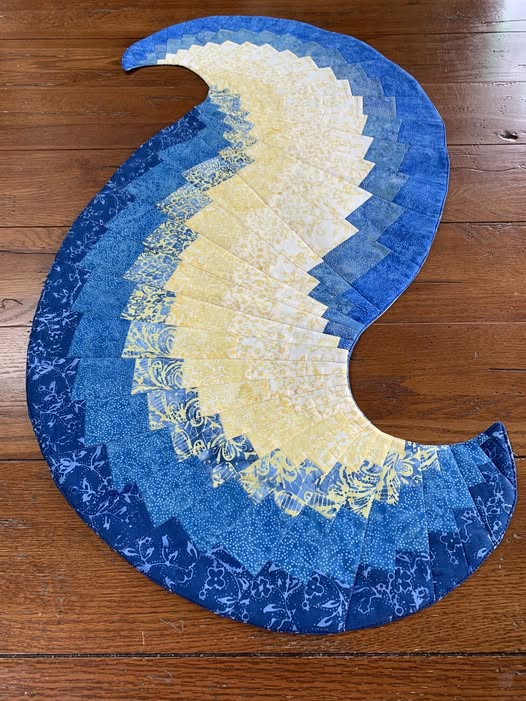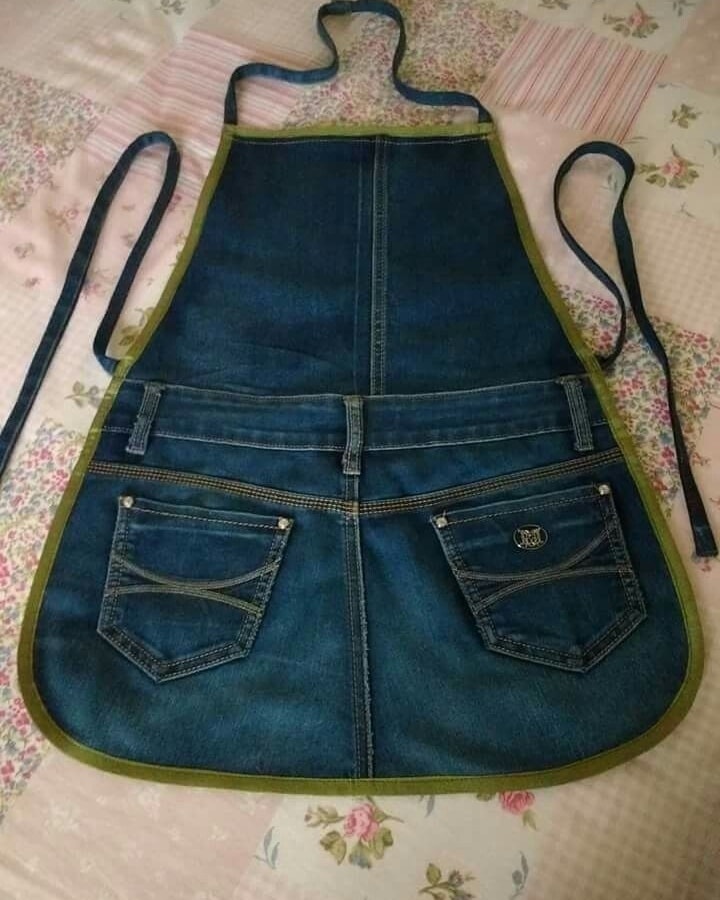
If you’re looking for a fun and eco-friendly way to refresh your wardrobe, how to create an apron from old jeans – free pattern is the perfect DIY project.
Upcycling old denim not only helps reduce waste, but it also gives you a sturdy, stylish apron that can be used in the kitchen, workshop, or garden. With this free apron pattern, even beginners can transform worn-out jeans into a functional and fashionable accessory.
Creating an upcycled denim apron allows you to combine practicality with creativity. Denim is naturally durable, which makes it ideal for aprons that will see regular use.

By following this guide, you can craft a personalized apron that fits comfortably, includes pockets for utensils or tools, and reflects your individual style.
What makes this project even more exciting is its versatility. You can decorate your apron with patches, embroidery, or paint to match your personality. Using a DIY apron tutorial, you can create a reusable and environmentally friendly piece of clothing, all while learning valuable sewing skills.
To begin how to create an apron from old jeans – free pattern, gather your materials carefully. Start with a pair of old jeans, ideally in a size that gives you enough fabric for the apron body and straps. Denim from jeans is durable, so it will make your apron long-lasting.
You will also need fabric scissors, pins, a sewing machine or needle and thread, and a measuring tape. Optional items include fabric chalk for marking, iron and ironing board for crisp edges, and embellishments like buttons or patches to personalize your apron.
If you want pockets on your apron, the jeans’ existing pockets can be repurposed. Alternatively, you can use additional scrap fabric to add larger or decorative pockets. This allows you to customize your upcycled denim apron for maximum functionality.
Selecting appropriate thread is important. Denim is thick, so choose a strong, high-quality thread to ensure durable seams. If you’re sewing by hand, a sharp needle suitable for heavy fabrics will make the process smoother.
Consider the type of jeans you’re using. Thicker denim provides sturdiness but may be harder to sew, while thinner denim is easier to handle but may require reinforcement in high-stress areas like pockets and straps.
Finally, plan your layout before cutting. Decide how much fabric will be used for the main apron body, straps, and pockets. Careful planning ensures efficient use of your old jeans while avoiding unnecessary waste.
Following the how to create an apron from old jeans – free pattern begins with carefully cutting the fabric. Remove the pant legs from the jeans and cut the back and front panels to create the apron body. Keep the waistband intact if you want to repurpose it as a top strap.
Next, cut the pant legs into long strips to form the apron ties. These will wrap around your waist and secure the apron comfortably. Denim strips are strong, so you won’t need additional reinforcement, but folding and stitching the edges improves durability and comfort.
If you want to add pockets, choose areas from the jeans with minimal wear. Sew them onto the front of the apron using strong, even stitches. This makes your DIY apron tutorial both practical and visually appealing. You can also decorate the pockets with embroidery or patches for a unique touch.
Once the pieces are prepared, assemble the apron. Pin the body and straps together, then sew along the edges. Reinforce high-stress areas like the corners of the pockets and the points where straps attach to the body. This ensures your upcycled denim apron can withstand regular use.
After sewing, trim any excess threads and press the seams with an iron. A neatly pressed apron not only looks professional but also makes the denim softer and easier to wear.
Finally, test the fit by tying the apron around your waist and adjusting the straps if needed. Your apron is now ready to use for cooking, crafting, or gardening, and you’ve successfully transformed old jeans into a functional and stylish accessory.
To achieve a polished result in your how to create an apron from old jeans – free pattern, pay attention to detail throughout the process. Start by measuring carefully to ensure the apron fits your body comfortably.
When cutting the denim, use sharp scissors to avoid frayed edges. Mark your cutting lines with fabric chalk to maintain accuracy and avoid mistakes. This simple step improves the overall look of your upcycled denim apron.
Seam allowances are important. Adding about half an inch around your cuts gives you space for sewing and helps prevent the fabric from unraveling over time. Denim can fray, so finishing edges with a zigzag stitch or serger is recommended.
Ironing each piece before assembly makes sewing easier. Pressing the fabric flattens wrinkles, aligns seams, and allows for precise stitching. This attention to detail contributes to a professional-looking apron.
Consider reinforcing areas that will bear weight, such as pockets or the attachment points for straps. Double-stitching these areas ensures durability, especially if your apron will be used for heavy-duty tasks.
Lastly, customize your apron to reflect your personality. Add decorative stitching, painted designs, or repurposed elements from other clothing. This not only enhances visual appeal but also makes your apron truly one-of-a-kind.
An upcycled denim apron made from old jeans is versatile. Beyond kitchen use, it can serve as a crafting apron, gardening apron, or even a workshop protector. The sturdy denim fabric is ideal for handling dirt, paint, or minor spills.
You can also create matching aprons for friends or family using different old jeans. This makes a thoughtful gift and encourages sustainable practices. Personalize each apron with embroidery, patches, or painted designs for unique results.
Repurposed denim aprons can be worn as casual outerwear during creative activities. The pockets provide functional storage for utensils, brushes, or small tools, making them both stylish and practical.
For a decorative twist, use the apron as a wall hanging or display piece. This creative approach turns your DIY apron tutorial into a functional art project that showcases your craftsmanship.
Pair your apron with other recycled clothing crafts, like tote bags or cushion covers, to create a cohesive eco-friendly set. This demonstrates sustainable creativity while enhancing your home decor.
Finally, consider making aprons in different sizes for children or pets. Repurposing old jeans into smaller aprons is a fun way to involve family members in eco-friendly DIY projects.
Q1: Is this project suitable for beginners?
Yes! The how to create an apron from old jeans – free pattern is beginner-friendly, with simple cutting and sewing steps.
Q2: Can I use any type of jeans?
Most jeans work well. Choose ones that are not too worn out or stiff. Thicker denim is more durable, while lighter denim is easier to sew.
Q3: Can I add pockets?
Absolutely! Repurpose the existing pockets or sew new ones from scrap fabric for a functional and decorative feature.
Q4: Do I need a sewing machine?
A sewing machine is faster and more durable for denim, but hand sewing is possible with a strong needle and thread.
Q5: How should I wash the apron?
Wash like normal denim. Turn inside out and use cold water to preserve color and prevent shrinking.
Q6: Can I decorate the apron?
Yes. Add embroidery, fabric paint, patches, or even buttons to personalize your apron and make it unique.
Learning how to create an apron from old jeans – free pattern is a fun, eco-friendly, and practical way to upcycle worn denim into a useful accessory. From choosing materials to cutting, sewing, and adding pockets, each step allows you to create a functional and stylish upcycled denim apron.
This project is perfect for beginners and experienced crafters alike, offering opportunities to customize, decorate, and repurpose old clothing. By making your own apron, you contribute to sustainability while enjoying the satisfaction of creating something useful and unique.
We’d love to hear your thoughts! Share your honest opinion and suggestions. How did your upcycled denim apron turn out? Did you add any personal touches or decorations? Your feedback can inspire other crafters to try this project and embrace creative upcycling.
